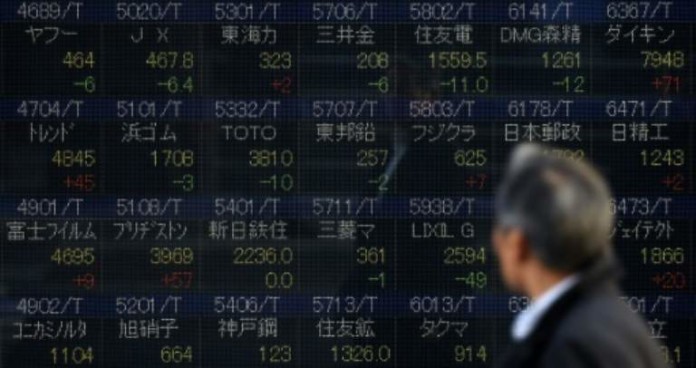Hong Kong (AFP) – Tokyo led another market sell-off on Thursday as equities and currencies succumbed again to a vicious rout that has ripped across global trading floors.
Any hope Wednesday’s regional rally might pressage a recovery from 2016’s bloodbath was wiped out with an immediate sell-off in the opening minutes.
Tokyo plunged almost four percent in the first hour and Shanghai fell below its lowest levels of the summer rout.
The losses came after Wall Street’s three main indexes dropped, with energy firms taking a hammering again as oil prices hit lows not seen since the first half of 2004.
That overshadowed a better-than-forecast Chinese trade report, which provided some rare good news about the world’s second biggest economy.
“It’s hard to get bullish at this stage,” Michael McCarthy, chief strategist at CMC Markets in Sydney, told Bloomberg News.
“The market focus keeps shifting whenever there’s positive news. We saw very good trade numbers from China yesterday and yet we’ve seen the rebound being short-lived as the focus shifted to commodities. Negative sentiment is dominating.”
Japan’s Nikkei was down 3.7 percent by lunch, while Hong Kong lost two percent, Sydney shed 1.8 percent and Seoul was 1.4 percent lower.
The losses swept away gains posted on Wednesday.
Shanghai fell 1.2 percent, having bucked the regional trend the previous day when it lost 2.4 percent. The index is now more than 17 percent down for the year already. It is the worst performer among 93 benchmark indexes tracked by Bloomberg.
– ‘Perfect storm’ –
Among the biggest losers were energy companies, with Santos diving more than seven percent in Sydney, Woodside losing 2.2 percent and Rio Tinto off 1.3 percent.
Hong Kong-listed CNOOC was 4.3 percent down and PetroChina shed 3.4 percent lower. Inpex in Tokyo shed five percent.
Crude prices continue to tumble, with news that US stockpiles had risen last week adding to the sense of gloom. The Brent contract on Wednesday fell below $30, a day after the US benchmark West Texas Intermediate (WTI) did the same.
While the two immediately ticked back up, the downward pressure remains as demand is tepid, the global economy is struggling and a supply glut shows no signs of easing.
The panicking also sent traders scurrying out of high-risk investments looking for safety, with the dollar rallying against emerging market currencies.
The South Korean won fell 0.7 percent, Indonesia’s rupiah shed 0.3 percent and the oil-reliant Malaysian ringgit shed 0.2 percent.
Australia’s dollar was 0.2 percent lower at US$0.6944, as data showing the unemployment rate was unchanged in December lent some support.
But the greenback retreated against the yen, which is considered a safe haven in times of trouble. The Japanese unit has now risen about 2.5 percent against the dollar this year.
“We’re in a perfect storm,” said Yousef Abbasi, global market strategist at JonesTrading Institutional Services LLC in New York.
“Even though we knew a lot of these factors in the past, they all seemed to come together at the start of 2016 to take a bite out of people. There’s a combination of a buyer’s strike, some disinterest, some confusion, and to be completely honest, some exasperation. Guys are frustrated.”
– Key figures at 0300 GMT –
Tokyo – Nikkei 225: DOWN 3.7 percent at 17,068.08 (break)
Shanghai – Composite: DOWN 1.2 percent at 2,915.75
Hong Kong – Hang Seng: DOWN 1.7 percent at 19,602.02
Euro/dollar: DOWN at $1.0890 from $1.0874 Tuesday
Dollar/yen: UP at 117.40 yen from $117.72 yen
New York – Dow: DOWN 2.2 percent at 16,151.41 (close)
New York – S&P 500: DOWN 2.5 percent at 1,890.28 (close)
New York – Nasdaq Composite: DOWN 3.4 percent at 4,526.06 (close)
London – FTSE 100: UP 0.5 percent at 5,960.97 (close)















